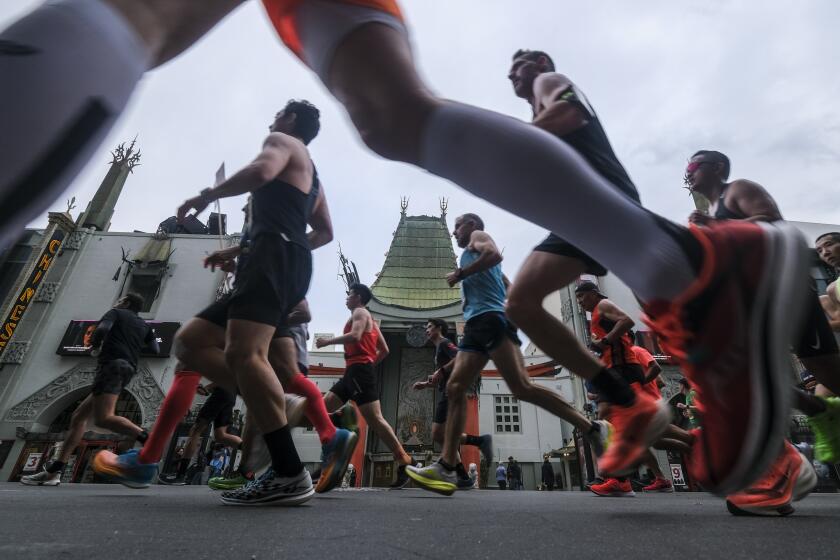Ludwig Göransson decodes his sometimes forward, sometimes backward ‘Tenet’ score
- Share via
“Tenet” opens with an orchestra tuning up. It’s setting the stage for a thrilling and chaotic action set piece inside a concert hall — but it’s also writer-director Christopher Nolan’s way of telling the audience it’s about to experience a uniquely musical thrill ride.
“Music has been such an increasing and fundamental part of the films I’ve made,” the director of “Inception” and “Interstellar” said in the recent book “The Nolan Variations.” “What I’ve done with the bigger film scores over the years is figure out a way to build the machine and then use the mechanism of the music to get to the heart of it.”
Nolan invited Ludwig Göransson over to his house for a meeting several months before shooting his latest film. The Oscar-winning composer of “Black Panther,” who has quickly become the hip-hop savvy, guitar-shredding, 21st century answer to John Williams with his anthemic scores for “Creed” and “The Mandalorian,” was unknowingly being courted to score “Tenet” as the two simply gabbed about music for hours. The next day, Göransson was invited back to read the script.
Christopher Nolan’s sci-fi espionage epic “Tenet” is now available to watch at home, and the director breaks down the groundbreaking car chase sequence.
“Tenet” is Nolan’s densely science-fictional take on the James Bond thriller, but essentially it’s about entropy and reverse entropy and a series of jaw-dropping action sequences that take place in that counterpointed slipstream of time. Göransson immediately began conceiving ways to communicate that musically, from old baroque techniques such as inverted melodies to cutting-edge electronic production and audio manipulation.
“You’re seeing everything from the Protagonist’s perspective,” Göransson said, referring to John David Washington’s otherwise unnamed character. “That was one thing that I wanted to tap into a lot, just being able to explain everything the way he’s feeling it. Sometimes the music also feels like it’s coming from the future — it feels like it’s guiding him too. And sometimes the music had to play forwards and backwards at the same time, because that’s what’s going on on the screen.”
Göransson made long, beat-driven, hypnotic demos inspired by the script, and Nolan had those tracks in his head while he was traversing six different countries across three continents. He would call Göransson from far-off locations and ask him for slight modifications to the music.
Back in the editing room in L.A., Nolan showed Göransson the bullet-riddled prologue that takes place in the concert hall in Tallinn, Estonia — and “it was an incredible experience,” said Göransson, “because it felt like he had shot it to my music, basically. It was so synced. At that moment, for me, it was like: OK, this is how Chris works. This is how he views music with picture. Now it’s game on.”
Nolan encouraged the composer to connect with the stunt choreographer, set designer and actors, and their choices ended up transforming his music — and vice versa. A dance choreographer worked with stunt actors to make the fight sequences look more like they were flowing backward in time, and there’s a propulsive, almost dance-like beat to much of the score.
In turn, Nolan played Göransson’s music for Washington — particularly demos with “the more high-energy 808s that come in, and like the fast, high, dancy tempos,” Göransson said. Nolan “got very excited, because he was really matching the performance of John David, [who] has such an explosive physique, and the way he runs and the way he moves.”
Sometimes Göransson’s score uses a melodic idea that is the same forward and backward, but he went even further down the rabbit hole — such as in the scene right before the final battle, where the rhythm section is playing in forward motion while the orchestra is playing the Protagonist’s theme backward. (The fact that this cue was recorded during the pandemic, with each instrumentalist playing their part remotely, made it all the more challenging.)
To create the feeling of backward music, Göransson had his musicians play some pieces normally, then he would reverse the audio recording and play it back for them and have them emulate what that reversed audio sounded like — and then reverse that recording.
In other words, the score is as much of a head trip as the movie, which has its share of confounded critics. But those who love “Tenet” surrender to it — much like surrendering to a dance groove. “Don’t try to understand it,” the film’s version of Q tells the Protagonist. “Feel it.”
According to the Protagonist himself: “Ludwig’s score helps emotionally track what is going on in the story,” said Washington. “It is like a guideline for the plot.”
Göransson did offer a kind of decoder ring: his theme for Neil (Robert Pattinson), which was partly inspired by his earliest foray into producing when he was a boy in Sweden, dialing the volume knob on his radio up and down. “If you listen closely and you listen to how it develops throughout the movie,” the composer said, “it answers a lot of questions you might have.”
More to Read
Sign up for The Envelope
Get exclusive awards season news, in-depth interviews and columnist Glenn Whipp’s must-read analysis straight to your inbox.
You may occasionally receive promotional content from the Los Angeles Times.










